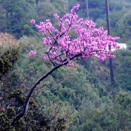Cercis silquastrum
Judas tree Κουτσουπιά
Leguminosae - pea family Dicot.
Cercis silquastrum
Judas tree Κουτσουπιά
Leguminosae - pea family Dicot.

In springtime, amongst the dark green of the the pines and the grey green of the olives, the abundant flowers of the Judas trees create bright, luminous splashes of brilliant purple. The flowers are arranged in circles with the flower stalks radiating from a central node, unusually they arise directly from old wood and appear before the leaves. The fruits are flattened reddish-brown pods, which develop over the summer months and often remain on the trees until new flowers appear the following spring.
The bright colour contrasts with the dark myths, which have become associated with the trees, probably by the association of the French name of the tree, Arbre de Judea, the tree of Judea with the name Judas. The flowers are edible and can be a colourful addition to salads.
cercis from kerkis (κέρκις) shuttle, from the shape of the pods.
silquastrum from siliqua, the latin name for pods, astrum from constellation
The Myth of the Judas Tree
The Judas tree, which flowers around Easter has become associated with the story of Judas Iscariot. It is believed thst it is the tree from which he hung himself, when he felt extreme guilt after betraying Jesuswith a kiss in the garden of Gethsemane. Previously the tree had been a tall, vigorous tree with strong boughs and pure white blossom but the flowers blushed red with shame, the trees growth was impaired and branches thinned, so it would never againbe able to be used for such a purpose. The way the pods and flowers hang from the branches is thought to represent the hanging body of Judas.

